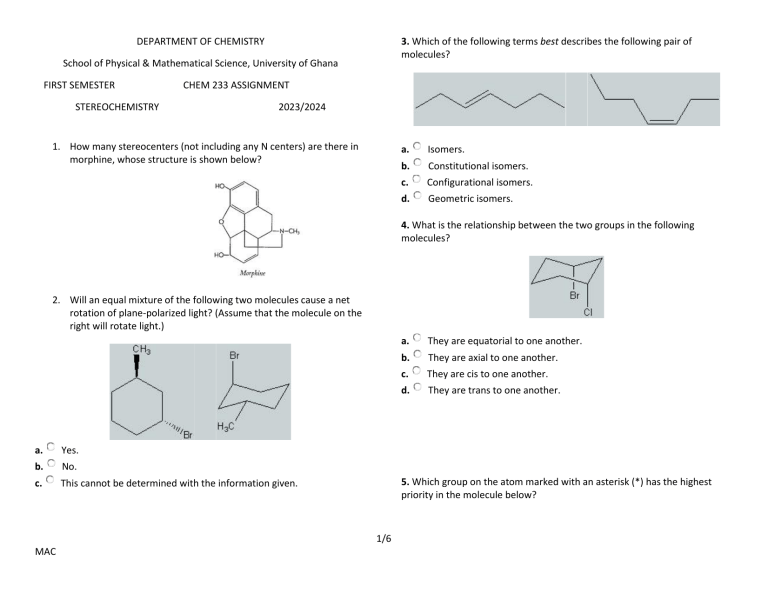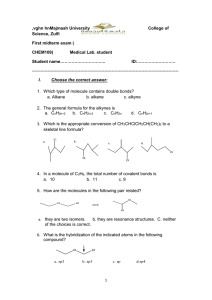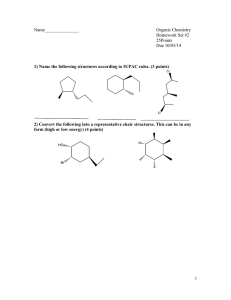
DEPARTMENT OF CHEMISTRY 3. Which of the following terms best describes the following pair of molecules? School of Physical & Mathematical Science, University of Ghana FIRST SEMESTER STEREOCHEMISTRY CHEM 233 ASSIGNMENT 2023/2024 1. How many stereocenters (not including any N centers) are there in morphine, whose structure is shown below? a. Isomers. b. Constitutional isomers. c. Configurational isomers. d. Geometric isomers. 4. What is the relationship between the two groups in the following molecules? 2. Will an equal mixture of the following two molecules cause a net rotation of plane-polarized light? (Assume that the molecule on the right will rotate light.) a. Yes. b. No. c. This cannot be determined with the information given. They are equatorial to one another. b. They are axial to one another. c. They are cis to one another. d. They are trans to one another. 5. Which group on the atom marked with an asterisk (*) has the highest priority in the molecule below? 1/6 MAC a. c. E. d. Z. 8. In the molecule below, how many stereocenters have an S orientation? a. The alcohol. b. The chlorine. c. The ethyl group. d. The carboxylic acid group. 6. What is the spatial orientation of the double bond in the molecule below? a. Zero (0). b. One (1). c. Two (2). d. Three (3). 9. What is the complete name of the molecule below, if the base name of the molecule is 3-bromo-5-isopropylcyclohexene? a. Cis. b. Trans. c. E. d. Z. 7. What is the spatial orientation of the stereocenter marked with an asterisk (*) in the molecule below? a. R. b. S. 2/6 MAC a. (3,R)-bromo-(5,R)-isopropyl-Z-cyclohexene. b. (3,S)-bromo-(5,S)-isopropyl-Z-cyclohexene. c. (3,S)-bromo-(5,R)-isopropyl-E-cyclohexene. d. (3,S)-bromo-(5,R)-isopropyl-Z-cyclohexene. 10. What is the stereochemical relationship between the following two molecules? levorotary of R configuration dextrorotary of S configuration 13. The specific rotation of a compound is denoted by the symbol: R S a. identical b. Enantiomers. c. Diastereomers. d. None of the above. [ ]D 14. Assign R or S configuration to the chiral carbon marked with an asterisk 11. What is the stereochemical relationship between the following two molecules? R S a. Identical. b. Enantiomers. c. Diastereomers. d. None of the above. 15. Assign the correct term describing the relationship to the following two isomers: 12. Optically active molecules which rotate plane-polarized light in a counterclockwise direction are said to be: 3/6 MAC a. is levorotary b. rotates plane-polarized light in a counterclockwise direction c. rotates plane-polarized light in a clockwise direction d. is racemic 18. Would the following compound have an enantiomer: enantiomers diastereomers identical 16. How many stereoisomers of S-Adenosylmethionone are possible in principle (Free Hint: there are 5 stereogenic centers): Yes No 19. Is the following compound meso: 8 16 Yes 32 No None of the Above 20. Does the following compound rotate plane-polarized light: 17. (R)-(+)-Glyceraldehyde: Yes 4/6 MAC b. Is the molecule chiral? _____ c. Does it have a plane of symmetry? _____ d. Is it optically active? _____ e. Is it a meso compound? _____ No CH 3 CH 2 CH 2CH 3 21. Label each asymmetric carbon with R or S. H H 23. A racemic mixture of 1-phenyl-2-propanamine can be resolved using malic acid whose structures are shown below. Malic acid 1-phenyl-2-propanamine The two compounds undergo acid base reaction to form salt. Fill in the boxes or the circles with the correct structure and configuration of the enantiomers and the diastereomers. 22. Consider the molecule at right, and answer each of the questions about it. a. Is it superimposable on its mirror image? _____ 5/6 MAC 25. Arrange these compounds in order of increasing boiling point a). Heptane b). 1,5-Pentanediol c). 1-Hexanol 26. Arrange these compounds in order of increasing solubility water a). 1-Butanol b). 1-Propanol c). 1,2-Dichloroethane 27. How would you prepare the following compounds from 2-methyl-1propanol A. (CH3)2CHCH2Br B. (CH3)2C=CH2 C. (CH3)2CHCH=O D. (CH3)2CHCO2H E. (CH3)2CHCH2OCOCH3 F. (CH3)2CHCO2C2H5 28. How would you distinguish among the following alcohols? Ethanol, 2-propanol and 2, 2-dimethyl-1-propanol 24. Give the IUPAC names of the following indicating stereochemistry where necessary. State the type of alcohol (Eg. Primary etc) c). (C2H5)2C(CH3)CH2OH d). (CH3)2CH]2CHOH f). (CH3)3C(CH2)3OH g). (CH3CH2CH2)2CHOH h). CH3CH2CH2CH(CH3)CH2CH2OH e). (C2H5)3COH 6/6 MAC



